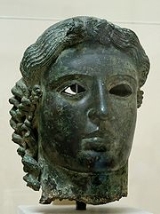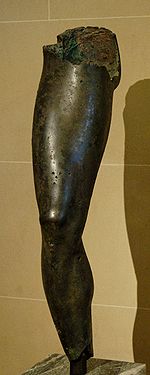
Chatsworth Head
Encyclopedia
The Chatsworth Head is a slightly over-life-size bronze
head dating to around 460 BC
which is now in the British Museum
.
, made up of various sections (e.g. head, arms, legs, some of the locks of hair) produced separately by lost-wax casting then joined into one whole - a leg from the same sculpture is in the Louvre
(Br 69). Its eyes probably originally held glass
, marble
or ivory
inlay
s, which were held in with surviving bronze plates, which curl outwards to form eyelash
es. Its lips seem to have been plated with reddish copper
to imitate their natural colour.

on Cyprus
and this immediately retirieved by locals who dragged it from its position using oxcarts. During its journey the statue fell apart losing legs, arms and its torso.
at Smyrna
from H.P. Borrell
in 1838. The other parts of the statue were lost, but it is believed that a leg in the was originally part of this statue.
The 6th Duke of Devonshire and his successors kept it at their residence of Chatsworth House
, from which it takes its name. It was loaned to the Fitzwilliam Museum
in the mid-1930s, and was acquired from the 11th Duke
by the British Museum
in 1958. It has the British Museum catalogue reference 1958 0418 1 and is on show there, in Room 15.
Bronze
Bronze is a metal alloy consisting primarily of copper, usually with tin as the main additive. It is hard and brittle, and it was particularly significant in antiquity, so much so that the Bronze Age was named after the metal...
head dating to around 460 BC
460 BC
Year 460 BC was a year of the pre-Julian Roman calendar. At the time, it was known as the Year of the Consulship of Poplicola and Sabinus...
which is now in the British Museum
British Museum
The British Museum is a museum of human history and culture in London. Its collections, which number more than seven million objects, are amongst the largest and most comprehensive in the world and originate from all continents, illustrating and documenting the story of human culture from its...
.
Description
The head was originally part of a complete statue, probably (judging by the shoulder-length curly hair) one of ApolloApollo
Apollo is one of the most important and complex of the Olympian deities in Greek and Roman mythology...
, made up of various sections (e.g. head, arms, legs, some of the locks of hair) produced separately by lost-wax casting then joined into one whole - a leg from the same sculpture is in the Louvre
Louvre
The Musée du Louvre – in English, the Louvre Museum or simply the Louvre – is one of the world's largest museums, the most visited art museum in the world and a historic monument. A central landmark of Paris, it is located on the Right Bank of the Seine in the 1st arrondissement...
(Br 69). Its eyes probably originally held glass
Glass
Glass is an amorphous solid material. Glasses are typically brittle and optically transparent.The most familiar type of glass, used for centuries in windows and drinking vessels, is soda-lime glass, composed of about 75% silica plus Na2O, CaO, and several minor additives...
, marble
Marble
Marble is a metamorphic rock composed of recrystallized carbonate minerals, most commonly calcite or dolomite.Geologists use the term "marble" to refer to metamorphosed limestone; however stonemasons use the term more broadly to encompass unmetamorphosed limestone.Marble is commonly used for...
or ivory
Ivory
Ivory is a term for dentine, which constitutes the bulk of the teeth and tusks of animals, when used as a material for art or manufacturing. Ivory has been important since ancient times for making a range of items, from ivory carvings to false teeth, fans, dominoes, joint tubes, piano keys and...
inlay
Inlay
Inlay is a decorative technique of inserting pieces of contrasting, often coloured materials into depressions in a base object to form patterns or pictures that normally are flush with the matrix. In a wood matrix, inlays commonly use wood veneers, but other materials like shells, mother-of-pearl,...
s, which were held in with surviving bronze plates, which curl outwards to form eyelash
Eyelash
An eyelash or simply lash is one of the hairs that grow at the edge of the eyelid. Eyelashes protect the eye from debris and perform some of the same function as whiskers do on a cat or a mouse in the sense that they are sensitive to being touched, thus providing a warning that an object is near...
es. Its lips seem to have been plated with reddish copper
Copper
Copper is a chemical element with the symbol Cu and atomic number 29. It is a ductile metal with very high thermal and electrical conductivity. Pure copper is soft and malleable; an exposed surface has a reddish-orange tarnish...
to imitate their natural colour.

Discovery
In 1834 The Louvre managed to purchase the first large bronze statue found in modren times after its discovery in Italy near the Island of Elba. Two years later a complete statue was discovered near TamassosTamassos
thumb|right|250px|Map showing the ancient city Kingdoms of CyprusTamassos is an ancient Greek city-state of great archaeological significance in the central vicinity of Cyprus, located approximately 21 kilometeres south-west of the capital city of Nicosia.-Ancient Tamassos:The city-state prospered...
on Cyprus
Cyprus
Cyprus , officially the Republic of Cyprus , is a Eurasian island country, member of the European Union, in the Eastern Mediterranean, east of Greece, south of Turkey, west of Syria and north of Egypt. It is the third largest island in the Mediterranean Sea.The earliest known human activity on the...
and this immediately retirieved by locals who dragged it from its position using oxcarts. During its journey the statue fell apart losing legs, arms and its torso.
Provenance
The head was acquired by the 6th Duke of DevonshireWilliam Cavendish, 6th Duke of Devonshire
William George Spencer Cavendish, 6th Duke of Devonshire KG, PC , styled Marquess of Hartington until 1811, was a British peer, courtier and Whig politician...
at Smyrna
Smyrna
Smyrna was an ancient city located at a central and strategic point on the Aegean coast of Anatolia. Thanks to its advantageous port conditions, its ease of defence and its good inland connections, Smyrna rose to prominence. The ancient city is located at two sites within modern İzmir, Turkey...
from H.P. Borrell
Henry Perigal Borrell
Henry Perigal Borrell was a British numismatist. He was the son of John Henry Borrell, a London clockmaker, and Kitty Howe. Having learned the numismatics trade in London, he traveled to the Ottoman Empire and set up home and shop in Smyrna as a trader, from 1818 right up until his death...
in 1838. The other parts of the statue were lost, but it is believed that a leg in the was originally part of this statue.
The 6th Duke of Devonshire and his successors kept it at their residence of Chatsworth House
Chatsworth House
Chatsworth House is a stately home in North Derbyshire, England, northeast of Bakewell and west of Chesterfield . It is the seat of the Duke of Devonshire, and has been home to his family, the Cavendish family, since Bess of Hardwick settled at Chatsworth in 1549.Standing on the east bank of the...
, from which it takes its name. It was loaned to the Fitzwilliam Museum
Fitzwilliam Museum
The Fitzwilliam Museum is the art and antiquities museum of the University of Cambridge, located on Trumpington Street opposite Fitzwilliam Street in central Cambridge, England. It receives around 300,000 visitors annually. Admission is free....
in the mid-1930s, and was acquired from the 11th Duke
Andrew Cavendish, 11th Duke of Devonshire
Andrew Robert Buxton Cavendish, 11th Duke of Devonshire KG, MC, PC , styled Lord Andrew Cavendish until 1944 and Marquess of Hartington from 1944 to 1950, was a British Conservative politician...
by the British Museum
British Museum
The British Museum is a museum of human history and culture in London. Its collections, which number more than seven million objects, are amongst the largest and most comprehensive in the world and originate from all continents, illustrating and documenting the story of human culture from its...
in 1958. It has the British Museum catalogue reference 1958 0418 1 and is on show there, in Room 15.

